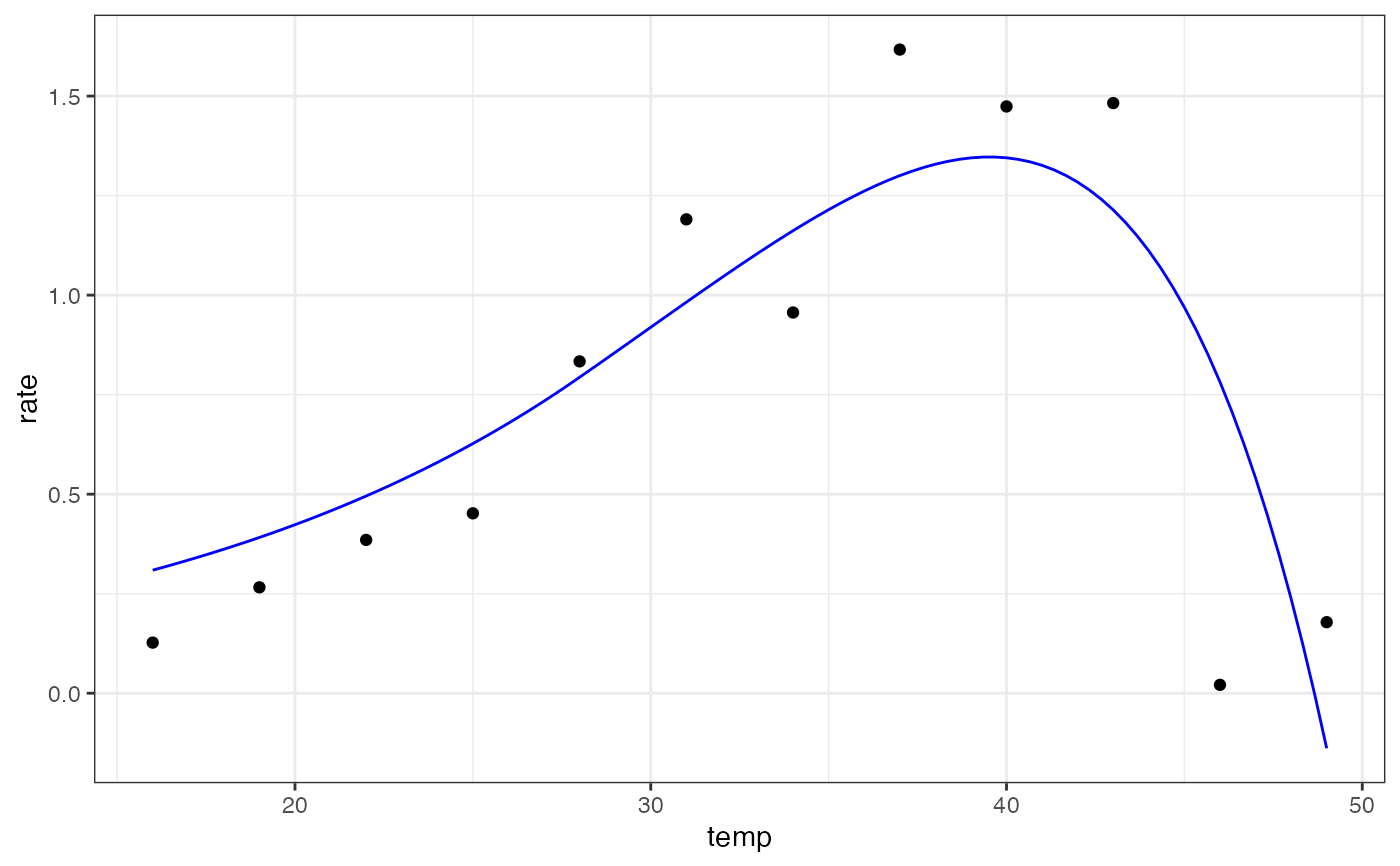Rezende model for fitting thermal performance curves
Arguments
- temp
temperature in degrees centigrade
- q10
defines the fold change in performance as a result of increasing the temperature by 10 ºC
- a
parameter describing shifts in rate
- b
parameter threshold temperature (ºC) beyond which the downward curve starts
- c
parameter controlling the rate of decline beyond the threshold temperature, b
Value
a numeric vector of rate values based on the temperatures and parameter values provided to the function
Details
Equation: $$\textrm{if} \quad temp < b: rate = a \cdot 10 ^{\frac{\log_{10} (q_{10})}{(\frac{10}{temp})}}$$ $$\textrm{if} \quad temp > b: rate = a \cdot 10 ^{\frac{\log_{10} (q_{10})}{(\frac{10}{temp})}} \cdot \bigg(1-c \cdot (b-temp)^2 \bigg)$$
Start values in get_start_vals are derived from the data and previous values in the literature.
Limits in get_lower_lims and get_upper_lims are based on extreme values that are unlikely to occur in ecological settings.
References
Rezende, Enrico L., and Francisco Bozinovic. Thermal performance across levels of biological organization. Philosophical Transactions of the Royal Society B 374.1778 (2019): 20180549.
Examples
# load in ggplot
library(ggplot2)
# subset for the first TPC curve
data('chlorella_tpc')
d <- subset(chlorella_tpc, curve_id == 1)
# get start values and fit model
start_vals <- get_start_vals(d$temp, d$rate, model_name = 'rezende_2019')
# fit model
mod <- nls.multstart::nls_multstart(rate~rezende_2019(temp = temp, q10, a, b, c),
data = d,
iter = c(4,4,4,4),
start_lower = start_vals - 10,
start_upper = start_vals + 10,
lower = get_lower_lims(d$temp, d$rate, model_name = 'rezende_2019'),
upper = get_upper_lims(d$temp, d$rate, model_name = 'rezende_2019'),
supp_errors = 'Y',
convergence_count = FALSE)
# look at model fit
summary(mod)
#>
#> Formula: rate ~ rezende_2019(temp = temp, q10, a, b, c)
#>
#> Parameters:
#> Estimate Std. Error t value Pr(>|t|)
#> q10 2.194462 1.646887 1.332 0.219
#> a 0.087894 0.162598 0.541 0.604
#> b 27.888234 34.821536 0.801 0.446
#> c 0.002319 0.007783 0.298 0.773
#>
#> Residual standard error: 0.3618 on 8 degrees of freedom
#>
#> Number of iterations to convergence: 38
#> Achieved convergence tolerance: 1.49e-08
#>
# get predictions
preds <- data.frame(temp = seq(min(d$temp), max(d$temp), length.out = 100))
preds <- broom::augment(mod, newdata = preds)
# plot
ggplot(preds) +
geom_point(aes(temp, rate), d) +
geom_line(aes(temp, .fitted), col = 'blue') +
theme_bw()

